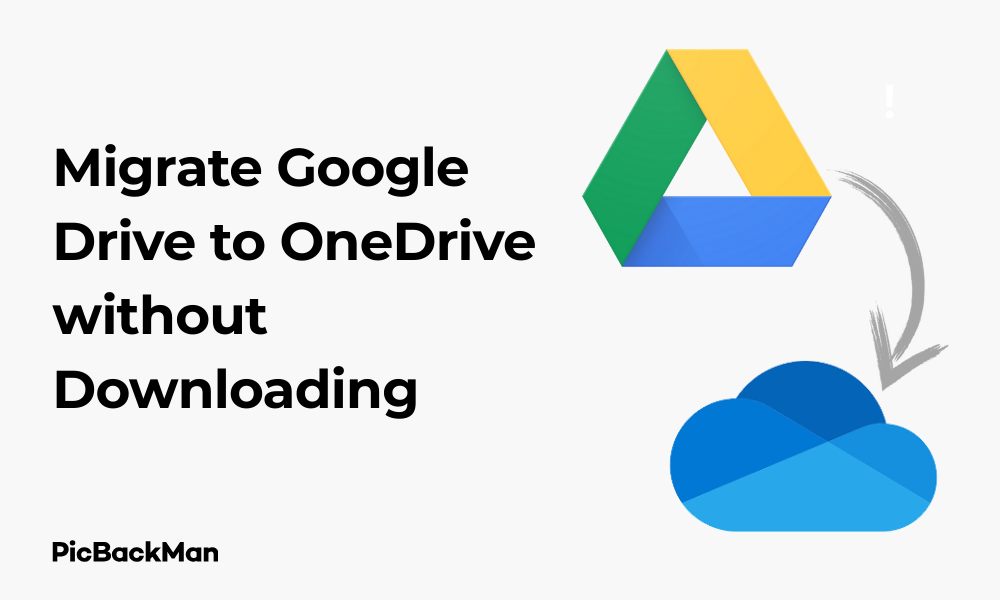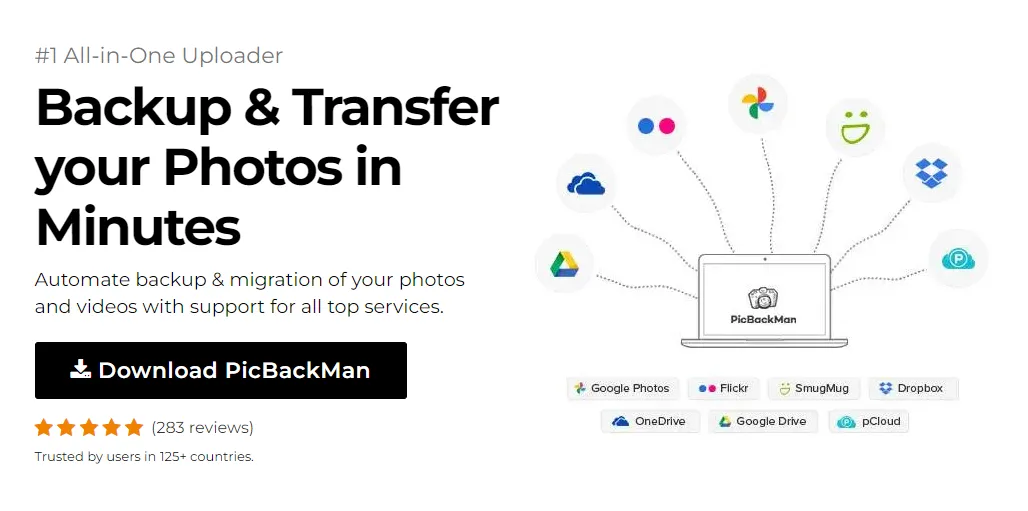
Why is it the #1 bulk uploader?
- Insanely fast!
- Maintains folder structure.
- 100% automated upload.
- Supports RAW files.
- Privacy default.
How can you get started?
Download PicBackMan and start free, then upgrade to annual or lifetime plan as per your needs. Join 100,000+ users who trust PicBackMan for keeping their precious memories safe in multiple online accounts.
“Your pictures are scattered. PicBackMan helps you bring order to your digital memories.”
Migrate Google Drive to OneDrive without Downloading - 6 Ways


Switching from Google Drive to OneDrive doesn't have to be a headache. If you're looking to transfer your files without the hassle of downloading everything to your computer first, you've come to the right place. This guide walks you through six practical methods to migrate Google Drive to OneDrive directly, saving you time, bandwidth, and storage space.
Whether you're changing jobs, consolidating your cloud storage, or simply prefer Microsoft's ecosystem, these solutions will help you move your data efficiently. Let's explore the most effective ways to transfer your files without clogging up your hard drive.
Why Migrate from Google Drive to OneDrive?
Before diving into the migration methods, let's quickly look at why you might want to make this switch:
- Better integration with Microsoft Office apps
- Your company uses Microsoft 365
- More storage options with certain Microsoft subscriptions
- Personal preference for OneDrive's interface
- Need to consolidate cloud storage services
Method 1: Using PicBackMan for Direct Google Photos to OneDrive Transfer
PicBackMan is a desktop application that automatically moves your Google Photos to OneDrive without the need to download and re-upload files manually. It works in the background and is ideal for transferring large photo and video libraries.
How to Migrate Using PicBackMan
- Download and install PicBackMan on your computer
- Sign in to your account or create a new one
- Connect your Google Photos account by authorizing access
- Connect your OneDrive account as the destination
- Select whether to move your entire library or specific albums
- Click "Migrate" and PicBackMan will transfer photos and videos automatically
Benefits of Using PicBackMan
- Automatic transfer without manual downloads or uploads
- Handles both photos and videos
- Preserves metadata such as creation dates and album organization
- Can process large libraries with minimal effort
- Runs in the background while you use your computer
Limitations of PicBackMan
- Requires installing the desktop app
- Needs internet connectivity throughout the transfer
- Some advanced features are available only on paid plans
Method 2: Using Mover.io (Microsoft's Official Migration Tool)
Microsoft acquired Mover.io to provide an official solution for migrating to OneDrive and SharePoint. This tool is particularly useful for business users and large-scale migrations.
How to Use Mover.io for Migration
- Go to mover.io and sign up for an account
- Click "Authorize New Connector" and select Google Drive as the source
- Authorize access to your Google Drive account
- Click "Authorize New Connector" again and select OneDrive as the destination
- Authorize access to your OneDrive account
- Select the files and folders you want to migrate
- Click "Start Copy" to begin the transfer process
Advantages of Mover.io
- Official Microsoft solution with reliable support
- Handles large migrations efficiently
- Preserves file permissions where possible
- Free for Microsoft 365 customers
- Excellent for business migrations
Drawbacks of Mover.io
- Primarily designed for business accounts
- May have limitations for personal accounts
- Interface can be less intuitive for beginners
Method 3: Using Cloudsfer for Customized Migration
Cloudsfer offers a specialized service for migrating between cloud storage providers with advanced customization options.
Step-by-Step Guide to Using Cloudsfer
- Visit Cloudsfer.com and create an account
- Select Google Drive as your source cloud
- Connect and authorize your Google Drive account
- Select OneDrive as your destination cloud
- Connect and authorize your OneDrive account
- Choose which files and folders to migrate
- Configure migration settings (file versions, permissions, etc.)
- Start the migration process
Cloudsfer Features
- Detailed migration reports
- Option to filter files by type, size, or date
- Preserves file metadata and timestamps
- Can handle file permission mapping
- Supports scheduled and incremental transfers
Cloudsfer Pricing Considerations
- Pay-as-you-go model based on data volume
- Starting price is around $6.90 per 20GB
- Volume discounts for larger migrations
- Free trial with limited data transfer
Method 4: Using AvePoint FLY for Enterprise Migrations
AvePoint FLY is a powerful migration tool designed for enterprise-level transfers with advanced features for large organizations.
How to Migrate with AvePoint FLY
- Contact AvePoint for a demo or trial of FLY
- Install and set up the FLY migration tool
- Connect your Google Workspace and Microsoft 365 accounts
- Map users and content between the platforms
- Configure migration settings and filters
- Run a test migration with a small data set
- Schedule and execute the full migration
Key Features of AvePoint FLY
- High-speed migration engine
- Detailed pre-migration assessment
- Preserves permissions, metadata, and sharing settings
- Supports incremental migrations
- Comprehensive reporting and logging
Best For
- Enterprise organizations
- Complex migration scenarios
- Migrations requiring detailed compliance and governance
- IT teams managing large-scale transfers
Method 5: Using rclone for Technical Users
rclone is a command-line program that connects to cloud storage providers and transfers files directly between them. It's free, open-source, and powerful for tech-savvy users.
How to Use rclone for Migration
- Download and install rclone from rclone.org
- Open a command prompt or terminal
- Run
rclone configto set up Google Drive and OneDrive connections - Configure your Google Drive remote by following the prompts
- Configure your OneDrive remote by following the prompts
- Use the command
rclone copy googledrive:path onedrive:pathto transfer files - Monitor the progress in the terminal window
Advanced rclone Options
- Use
--progressflag to see detailed transfer progress - Use
--transfers=nto set the number of simultaneous transfers - Use
--checkers=nto set number of checkers - Use
--excludeand--includeto filter files
Sample rclone Command for Migration
rclone copy googledrive: onedrive: --progress --transfers=4 --checkers=8Pros and Cons of rclone
| Pros | Cons |
|---|---|
| Completely free and open-source | Requires technical knowledge |
| Very powerful and flexible | Command-line interface may introduce beginners |
| Fast transfer speeds | No graphical user interface |
| Works on Windows, Mac, Linux | Setup process can be complex |
| Can be automated with scripts | Limited user support |
Method 6: Using Cloud Storage Manager Apps
Several mobile and desktop apps can manage multiple cloud storage accounts and transfer files between them. These apps provide a user-friendly interface for cloud-to-cloud transfers.
Popular Cloud Storage Manager Apps
- AirExplorer
- CloudHQ
- odrive
- Insync
- ExpanDrive
How to Use AirExplorer for Migration
- Download and install AirExplorer from airexplorer.net
- Launch the application and add your Google Drive account
- Add your OneDrive account
- In the main interface, navigate to your Google Drive files
- Select the files/folders you want to transfer
- Right-click and select "Copy to"
- Choose your OneDrive account as the destination
- Click "OK" to start the transfer
Features of Cloud Storage Manager Apps
- Graphical user interface for easy navigation
- Drag-and-drop functionality
- File preview capabilities
- Search across multiple cloud accounts
- Synchronization options
Limitations of Storage Manager Apps
- May use your computer as an intermediary
- Full features often require paid subscriptions
- Transfer speeds may vary based on your internet connection
- May not preserve all file metadata
Comparison of Google Drive to OneDrive Migration Methods
| Method | Ease of Use | Speed | Cost | Best For |
|---|---|---|---|---|
| PicBackMan | Very Easy | Fast | Free/Paid | Automatic photo & video transfers, personal & business users |
| Mover.io | Medium | Fast | Free for M365 | Business users, large migrations |
| Cloudsfer | Medium | Fast | Pay per use | Users needing customization |
| AvePoint FLY | Complex | Very Fast | Enterprise pricing | Large organizations |
| rclone | Difficult | Very Fast | Free | Technical users |
| Storage Manager Apps | Easy | Varies | Free/Paid | Casual users |
Tips for a Successful Migration
No matter which method you choose, these tips will help ensure a smooth migration experience:
Before Migration
- Clean up your Google Drive by removing unnecessary files
- Check that you have enough storage space in OneDrive
- Make sure your OneDrive account is properly set up
- Create a list of important files that must be transferred
- Consider how to handle Google-specific file formats
During Migration
- Start with a small test migration to verify everything works
- Monitor the process to catch any errors
- Don't modify files in either location during transfer
- For large migrations, consider breaking them into smaller batches
- Keep track of progress, especially for large transfers
After Migration
- Verify that all files transferred correctly
- Check file permissions and sharing settings
- Test opening important documents in OneDrive
- Update any links or bookmarks to point to the new location
- Consider keeping Google Drive active temporarily as a backup
Handling Google-Specific File Formats
Google Docs, Sheets, and Slides use Google's proprietary formats, which can cause complications when migrating to OneDrive. Here's how to handle them:
Option 1: Convert to Microsoft Office Formats
Most migration tools offer the option to convert Google formats to Microsoft Office formats during transfer:
- Google Docs → Word (.docx)
- Google Sheets → Excel (.xlsx)
- Google Slides → PowerPoint (.pptx)
- Google Drawings → Image files (.png or .jpg)
Option 2: Export Manually Before Migration
For greater control, you can export important Google files manually:
- Open the Google file
- Go to File > Download
- Select the appropriate format (Word, Excel, PowerPoint)
- Upload the converted file to OneDrive
Potential Issues with File Conversion
- Some formatting may change during conversion
- Comments might not transfer perfectly
- Complex spreadsheet functions may need adjustment
- Collaborative editing features work differently between platforms
Security Considerations During Migration
When transferring files between cloud services, security should be a top priority:
Authentication and Authorization
- Only use reputable migration services
- Check what permissions you're granting to third-party tools
- Use OAuth authentication when available
- Revoke access permissions after migration is complete
Data Protection
- Verify that migration tools use encrypted connections (HTTPS)
- Check if the service stores your files temporarily during transfer
- Be cautious with highly sensitive documents
- Consider migrating sensitive files separately with extra precautions
Business Compliance
- Ensure the migration process complies with your organization's data policies
- Verify that the migration tool meets any industry regulations (GDPR, HIPAA, etc.)
- Document the migration process for audit purposes
- Consult with IT security if you're unsure about compliance requirements
Troubleshooting Common Migration Issues
Even with careful planning, you might encounter some challenges during migration. Here's how to address common problems:
Failed Transfers
- Check your internet connection stability
- Verify that neither cloud service is experiencing downtime
- Ensure you haven't exceeded storage limits on OneDrive
- Try transferring problematic files or folders separately
- Check if file names contain special characters that might cause issues
Missing Files After Transfer
- Look for files in the root directory of OneDrive
- Check if files were moved to a different folder structure
- Verify if files were filtered out due to size or type restrictions
- Check if the migration tool has logs showing what happened
- Try a different migration method for the missing files
Slow Transfer Speeds
- Try scheduling transfers during off-peak hours
- Check if your migration tool has bandwidth limitations
- Reduce the number of files transferred in a single batch
- Prioritize important files and transfer them first
- Consider upgrading to a paid tier for faster transfers
File Permission Issues
- Manually check sharing settings for important files
- Re-share files with appropriate users after migration
- Note that sharing models differ between Google and Microsoft
- Use migration tools that specifically support permission mapping
Frequently Asked Questions
Can I migrate from Google Drive to OneDrive for free?
Yes, you can migrate from Google Drive to OneDrive for free using several methods. MultCloud offers a free tier with up to 30GB of data transfer per month, rclone is completely free and open-source, and Mover.io is free for Microsoft 365 subscribers. For small migrations, these free options work well, though they may have limitations on speed or features compared to paid alternatives.
How long does it take to migrate from Google Drive to OneDrive?
The migration time depends on several factors: the amount of data being transferred, the method you're using, your internet connection, and current load on the cloud services. Small migrations (under 10GB) might take less than an hour, while large migrations (100GB+) could take several days. Cloud-to-cloud transfer services typically process 1-5GB per hour on free tiers, with faster speeds on paid plans.
Will I lose file sharing permissions when migrating to OneDrive?
Most basic migration methods don't preserve sharing permissions, as Google Drive and OneDrive use different sharing models. Enterprise migration tools like AvePoint FLY and Mover.io attempt to map permissions between platforms, but some manual reconfiguration is typically needed. It's best to document important sharing settings before migration and plan to review and reset them later.
What happens to Google Docs files when migrated to OneDrive?
When migrating Google Docs, Sheets, and Slides to OneDrive, you have two main options: convert them to Microsoft Office formats (Word, Excel, PowerPoint) or keep them as links to the original Google files. Most migration tools offer conversion options, but be aware that complex formatting or features might not transfer perfectly. For critical documents, it's worth checking them after conversion.
Can I keep using Google Drive after migrating to OneDrive?
Yes, you can continue using both services after migration. Many users maintain accounts on multiple cloud platforms for different purposes or as backups. If you're migrating to consolidate storage, you might want to keep Google Drive active temporarily to ensure everything transferred correctly before removing files or canceling the service. Just be mindful of potential confusion from having files in multiple locations.
Quick Tip to ensure your videos never go missing
Videos are precious memories and all of us never want to lose them to hard disk crashes or missing drives. PicBackMan is the easiest and simplest way to keep your videos safely backed up in one or more online accounts.
Simply download PicBackMan (it's free!) , register your account, connect to your online store and tell PicBackMan where your videos are - PicBackMan does the rest, automatically. It bulk uploads all videos and keeps looking for new ones and uploads those too. You don't have to ever touch it.
Conclusion
Migrating from Google Drive to OneDrive without downloading files is entirely possible with the right tools and approach. Whether you choose a user-friendly service like MultCloud, an enterprise solution like AvePoint FLY, or a technical approach with rclone, the key is selecting the method that best fits your specific needs, technical comfort level, and budget.
Remember to prepare thoroughly before migration, monitor the process carefully, and verify your files afterward. Pay special attention to Google-specific file formats and security considerations throughout the transfer. With proper planning and execution, you can smoothly transition your files from Google Drive to OneDrive without the hassle of downloading everything to your device first.
By following the methods outlined in this guide, you'll save time, bandwidth, and storage space while ensuring your important files make the journey safely to their new cloud home.






